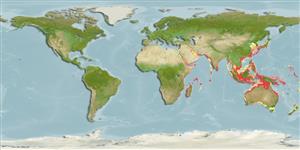Common names from other countries
Issue
Genus Hypodytes, according to Paxton et al. 1989 (Ref. 7300).
Environment: milieu / climate zone / depth range / distribution range
Ecologie
marien demersaal; diepte 14 - 60 m (Ref. 30573), usually 15 - 50 m (Ref. 4313). Deep-water
Indo-West Pacific: Red Sea and the Persian Gulf south to Natal, South Africa and east to India and the Philippines, north to China and Japan, south Australia.
Grootte / Gewicht / Leeftijd
Maturity: Lm ? range ? - ? cm
Max length : 20.0 cm TL mannelijk / geslacht onbekend; (Ref. 48635); common length : 10.0 cm TL mannelijk / geslacht onbekend; (Ref. 3503)
Dorsale stekels (totaal) : 14 - 16; Dorsale zachte stralen (totaal) : 8 - 10; Anale stekels: 3 - 4; Anale zachte stralen: 6 - 8. Bluish grey in color, belly pale; large black spot on rear half of spinous dorsal (Ref. 4313).
Inhabits soft bottoms of the continental shelf. Primarily known from trawls over prawn-grounds but divers looking in suitable habitats can come across them, especially at night. During the day it buries itself deep in the sand with just the eyes exposed. When disturbed, it spreads its long pectoral fins with the bright upper color to deter predators. It uses its fins to corner prey and has sensitive barbels below the mouth to detect those buried in the substrate (Ref. 48635). Fin spines venomous (anterolateral glandular groove with venom gland (Ref. 57406)) (Ref. 30573). Sold in small quantities either fresh or dried and salted in markets. Minimum depth reported taken from Ref. 57178.
Levenscyclus en paargedrag
Maturities | Voortplanting | Spawnings | Egg(s) | Fecundities | Larven
Poss, S.G. and K.V. Rama Rao, 1984. Scorpaenidae. In W. Fischer and G. Bianchi (eds.) FAO species identification sheets for fishery purposes. Western Indian Ocean (Fishing Area 51). Vol. 4. FAO, Rome. pag. var. (Ref. 3503)
Status op de Rode Lijst van het IUCN (Ref. 130435)
CITES (Ref. 128078)
Not Evaluated
Gebruik door de mens
Visserij: van minder commercieel belang
Tools
Speciale rapporten
Download XML
Internetbronnen
Estimates based on models
Preferred temperature (Ref.
115969): 23.3 - 29, mean 28 (based on 1680 cells).
Fylogenetische diversiteitsindex (Ref.
82804): PD
50 = 1.1250 [Uniqueness, from 0.5 = low to 2.0 = high].
Bayesian length-weight: a=0.01175 (0.00462 - 0.02990), b=3.02 (2.80 - 3.24), in cm Total Length, based on LWR estimates for this (Sub)family-body shape (Ref.
93245).
Trofisch niveau (Ref.
69278): 3.6 ±0.4 se; based on size and trophs of closest relatives
Fishing Vulnerability (Ref.
59153): Low vulnerability (10 of 100).
